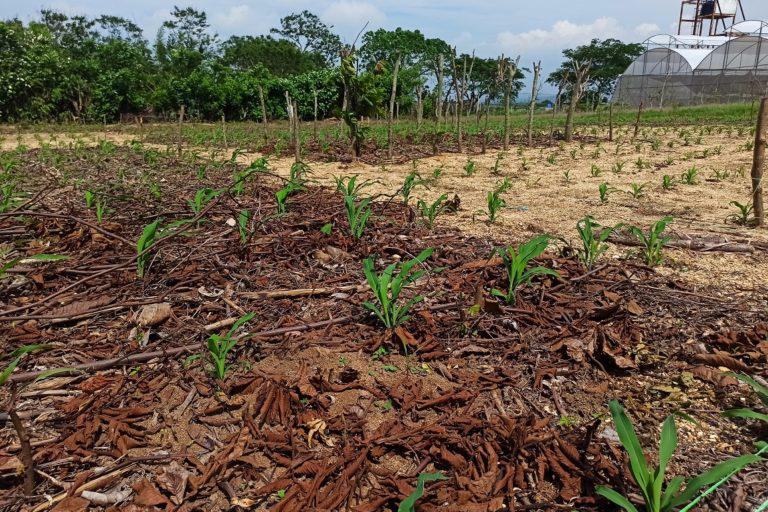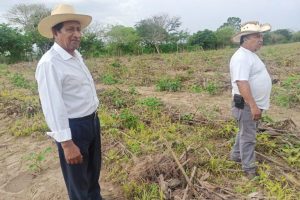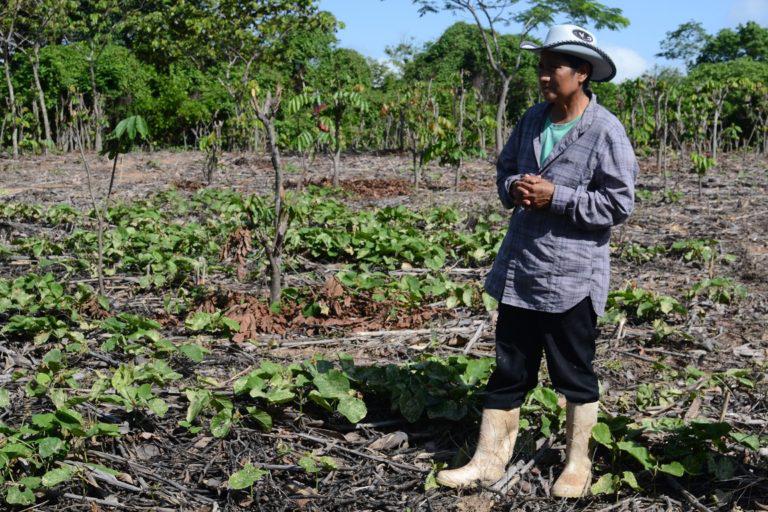- Chiapas is Mexico’s second-most biodiverse state and provides 30% of the country’s freshwater, but has lost 55% of its forests for farmland and livestock pasture.
- Now, an unlikely alliance of conservationists, farmers and cattle ranchers is working to incorporate 2.5 million hectares (6.2 million acres) of land into sustainable management schemes, focusing on soil health and aiming to restore and reforest 1.4 million hectares (3.5 million acres).
- The initiative intends to restore soil health and in the process store carbon, free up more land for conservation, and maintain jobs in rural areas.
NUEVO MEXICO, Mexico — Standing in her cornfield in Chiapas state, surrounded by mountains and dry tropical forests, Maria Luisa Gordillo Mendoza looks concerned. “They said we were pigs for sowing like this,” she says of the other farmers’ reaction to her fields covered with sticks and old corn husks and dotted with lanky trees.
Yet Mendoza’s unorthodox farming method in Chiapas, in southeastern Mexico, are gaining recognition for restoring soil health, as well as making more money for farmers, freeing up land for conservation, and storing carbon in the ground.
Traditionally, Mendoza says, farmers in the region would clear their fields in preparation for planting by burning the stubble on the ground and spraying agrochemicals — herbicides to kill the weeds and fertilizers to boost the crops.
“My dad taught me the same thing,” Mendoza tells Mongabay. “But my plot became quite poor, it became so impoverished that it turned sandy and hard. So, the corn, if it grew at all, didn’t yield very much.”
The fall in productivity at Mendoza’s farm mirrors a wider trend in the Central American Dry Corridor, the dry tropical forest region that stretches from Chiapas to Panama. Here, lower crop yields and higher food insecurity linked to climate change and land degradation are some of the main drivers behind migration, according to a 2019 report.
Mendoza says that in a year with good rains, she would harvest maybe around 2.5 metric tons of corn per hectare (about 1.1 short tons per acre). Sometimes the droughts would kill her father’s entire crop, she remembers, forcing the family to survive by foraging for plantains and native breadnut fruit (Brosimum alicastrum), a staple food of the ancient Maya. Yet these days, with technical assistance and working to boost soil health, her corn yields have grown to 8.5 metric tons per hectare, or 3.8 short tons an acre.
“Due to the subsoil now there is enough water down there even with 40 days of drought,” Mendoza says, pointing to her green-patched fields.
In-the-field studies
“Corn in particular is one of the most damaging crops to natural resources mainly because of its management and because some government programs have encouraged the destruction of natural resources,” says Walter Lopez Baez, Chiapas coordination and liaison director with the Mexican government’s National Institute of Forestry, Agriculture and Livestock Research (INIFAP).
Baez, who has worked with farmers in the region for more than 30 years, tells Mongabay that although crop productivity initially increased after the start of the Green Revolution in Mexico in the 1940s — a farming model that promoted high-yielding crop varieties and the use of chemical fertilizers and pesticides — yields began dropping about 20 years ago, despite the continued intensive use of agrochemicals.
In 2010, INIFAP worked with The Nature Conservancy (TNC) to analyze 300 plots in Chiapas, Mendoza’s among them, and found similar results. Results showed that soils had high levels of acidity and aluminum, were lacking nutrients, and were highly compacted from tractors. This meant roots couldn’t grow deep, creating drainage problems — all signs of bad land management, according to Baez.

NIFAP’s Chiapas experimental field center displays different planting methods (e.g. with biomass, without and with fertilizers). Image by Dimitri Selibas.
“Farmers were saying that the soil was tired,” Baez says. “It’s extractive agriculture where you’re not giving anything back to the soil, unlike what happens in forests.” Based on research in Guatemala and Honduras, the team began to experiment with intercropping the corn with species that can help the soils recover, focusing on two key species: the trailing legume Canavalia and the ice cream-bean, Inga edulis, locally known as guama. This practice is part of agroforestry, an agricultural system combining trees with growing crops and raising livestock which not only produces food, but supports biodiversity, builds organic content in soils, boosts water table levels and sequesters carbon from the atmosphere. Both the guama and the Canavalia are part of the Fabaceae or bean family, and as such have roots that fix nitrogen in the soil. They also grow quickly, making them a “permanent biomass factory,” providing a cover of organic matter on the ground surface that maintains soil moisture, breaks down nutrients for other plants, and prevents the growth of weeds, thereby reducing the need for herbicides.
The research showed using traditional methods resulted in an average yield of 3.5 metric tons per hectare (1.6 short tons per acre) with an investment of roughly $865 per hectare ($350 per acre), Baez tells Mongabay. Yet an additional investment of between $312 and $480 per hectare ($126-$194 per acre), could bring yields up to 7 metric tons per hectare (3.1 short tons per acre) in the first year and maintain that level going forward.
While this increase in revenue is important for farmers, Baez says it also has wider community benefits: boosting water availability, reducing particulate matter in the air from fires, and capturing more carbon from the atmosphere. Additionally, INIFAP found that regenerative methods alleviate compacted soils, allowing moisture to penetrate deeper into the ground even during droughts.
Connecting farming to conservation
“In a forest there is a lot of diversity and yet there is no chemical fertilization, there is no control, there is no use of insecticides or herbicides, and a forest is super productive and resilient,” says Alejandro Hernandez, TNC’s Chiapas coordinator, who has worked on conservation issues with communities in the region for more than 40 years. “We are copying the forest model and applying it using agroforestry systems.”
Chiapas is Mexico’s second-most biodiverse state and provides 30% of the country’s freshwater, so using agroforestry here becomes especially important, Hernandez tells Mongabay. He notes that greenhouse gas emissions in Mexico’s industrialized north come mainly from industry and motor vehicles, while in the south the main emitters are agriculture and cattle ranching. This is abundantly apparent in Chiapas, where 55% of the state’s forests having been cleared for farmland and pasture.
Hernandez says inefficient production systems are pushing farmers and ranchers to either abandon their fields or cut down more forests for more land. This doesn’t solve the problem, he says, as continuing these bad practices only increases the need for more land after just a few years, putting pressure on the remaining forests.
The solution requires seeing farmers and ranchers as allies rather than as threats, Hernandez says. By working together with conservationists to find models that are economically attractive to producers, he says, food and water security issues can be addressed while agricultural expansion into forests can be stopped and lost forests can be restored.
“I think that generates more empathy between both sides, because then we aren’t fighting,” Hernandez says. “If we do this right, we’re going to free up for restoration areas in marginal zones that are not suitable for agriculture.”
In Chiapas, TNC plans to massively scale up these impacts through Vision 2030, a road map for incorporating 2.5 million hectares (6.2 million acres) of land into sustainable agriculture and cattle-ranching schemes by 2030, as well as restoring and reforesting 1.4 million hectares (3.5 million acres) of land. In addition to corn, the project will also focus on beans and coffee, which are grown extensively in the state.
The initiative seeks to build a broad alliance. The Mexican environment ministry’s climate change fund is providing $340,000 for the project, while INIFAP is contributing $150,000 and TNC is sourcing funding from its international “Plant a Billion Trees” campaign.
Vision 2030 will also form part of TNC’s broader initiatives across Latin America, such as the Regenerative Ranching and Agriculture (R2A) strategy, which managed to restore 5 million hectares (12.4 million acres) of degraded soil and capture 550 million metric tons of carbon in Argentina, Brazil, and Colombia between 2018 and 2020.
The climate implications
The most comprehensive report yet from the U.N.’s Convention to Combat Desertification (UNCCD) makes the case that land restoration can act as a cost-effective solution for multiple issues, including climate change, biodiversity conservation, and forced migration. Published in April 2022, the Global Land Outlook 2 (GLO2) report notes that soil health and biodiversity are the foundation of societies and economies, as roughly $44 trillion of economic output — or more than half of global GDP — is moderately or highly reliant on natural capital.
“Land is really the overlooked issue when it probably should be the one with the most attention, because that’s where we live,” said Miriam Medel, the UNCCD’s chief of external relations, policy, and advocacy, who led the production of the report. “Land … is the connector between biodiversity and climate change and between humans and nature.”
Speaking to Mongabay at the launch of the report, Medel said their findings showed that 99% of the resources that humans use come from land, and 99% of the calories we consume, even if limited to just fish, would come from land in one way or another.
The GLO2 report also says that when supported by the right policies and regulations, improved soil health will increase not only land productivity and biodiversity, but also the total amount of carbon sequestered.
Scaling up solutions
The sight of bare soils and farmers working in their fields with herbicide tanks on their backs is still a common sight in rural Chiapas. And while Vision 2030 provides a blueprint for a nature-positive food system in the state, there’s still a long way to reach the 2030 targets: only 200 hectares (495 acres) of corn are under regenerative agriculture, out of the 700,000 hectares (1.7 million acres) under conventional production.

- In the municipality of Tiltepec, which joined the Vision 2030 initiative, the burning of fields has been banned and regenerative agriculture techniques were implemented. Image by Dimitri Selibas.
Yet more communities are already joining the Vision 2030 initiative. In the municipality of Tiltepec, the community council decided to protect and reforest the entire 3,000-hectare (7,400-acre) watershed, banning the burning of fields and implementing regenerative agriculture techniques. Yields subsequently went up from 1.5 to 5 metric tons per hectare (0.7 to 2.2 short tons per acre) in the first year. The community hopes to soon increase this to 8 metric tons per hectare (3.6 short tons per acre).
Global events have also driven more farmers to look for alternatives. Farmers in Chiapas were already feeling the pinch of rising fertilizer prices in recent years, blamed on the international energy crisis. The Russian war in Ukraine, between two of the world’s biggest producers of fertilizers, has further restricted supplies, leading to a tripling of the chemicals’ prices in the Mexican market.
The value of moving away from agrochemical inputs is being increasingly recognized. A 2018 study in the U.S. showed that regenerative corn fields generate nearly twice the profit of conventionally managed ones, largely because legume-based cover crops can reduce fertilizer costs, with these accounting for 32% of gross income for conventional fields versus 12% in regenerative fields.
A study published this year in the journal Nature Sustainability also shows that using ecological processes to replace human-produced inputs like pesticides and fertilizers can maintain or increase food production, while reducing the environmental and economic input costs.
“Both for us as technicians and for them as producers, we have to unlearn many things,” Baez says. “It was very hard for me to let go of many things that I learned in college, [where] they taught us a lot of chemistry, and for them as producers, everything they learned from their fathers … We are rethinking a lot of knowledge.”
Citations:
LaCanne, C. E., & Lundgren, J. G. (2018). Regenerative agriculture: Merging farming and natural resource conservation profitably. PeerJ, 6, e4428. doi:10.7717/peerj.4428
MacLaren, C., Mead, A., van Balen, D., Claessens, L., Etana, A., de Haan, J., … Storkey, J. (2022). Long-term evidence for ecological intensification as a pathway to sustainable agriculture. Nature Sustainability. doi:10.1038/s41893-022-00911-x
This article originally appeared in Mongabay. Reprinted with permission.
Organic & Non-GMO Insights October 2022





